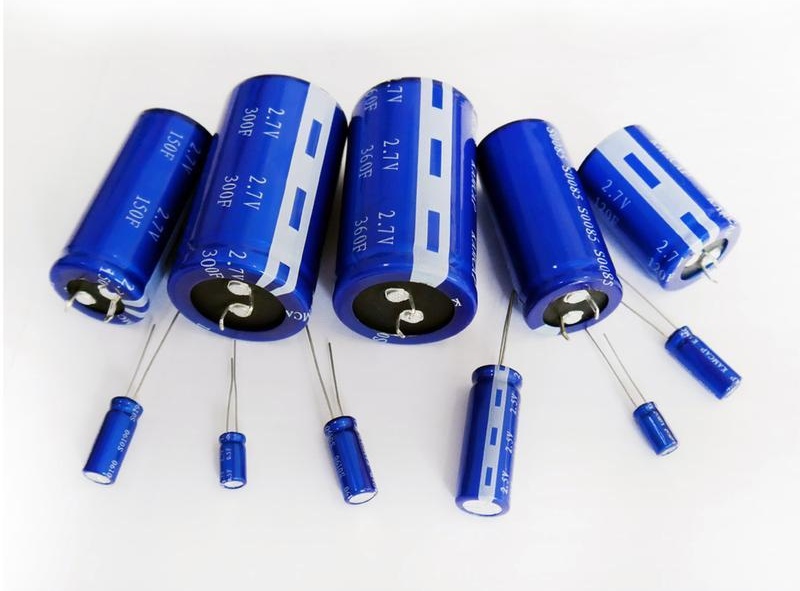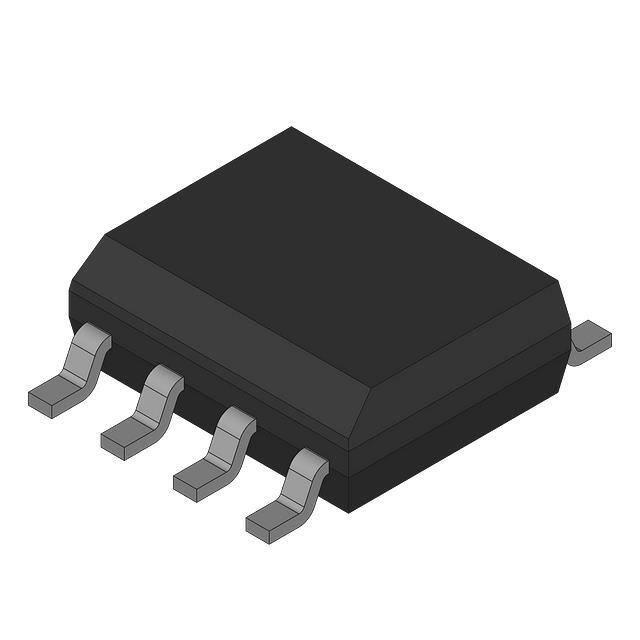What is a Farad capacitor? Advantages and disadvantages of Farad capacitors
Farad capacitors, also known as supercapacitors and gold capacitors, are capacitors with special properties. Their capacitance can reach the Farad level or even higher, which is much higher than the capacity of ordinary capacitors.

The working principle of Farad capacitors is mainly based on the double layer principle and pseudocapacitance principle
Double layer principle
Charge separation and adsorption: The electrode material of Farad capacitors has a very large specific surface area, and usually uses porous materials such as activated carbon. When the electrode contacts the electrolyte, charge separation occurs on the electrode surface. Since the surface of the electrode material carries a charge, it will attract ions with opposite charges in the electrolyte, so that these ions form a tight charge layer near the electrode surface, which is the so-called double layer. The formation of a double layer is equivalent to forming a capacitor between the electrode and the electrolyte. Its capacitance is related to factors such as the specific surface area of the electrode, the properties of the electrolyte, and the distance between the electrode and the electrolyte.
Charge storage and release: During the charging process, the external power supply transports electrons to the electrode, making the electrode surface negatively charged, attracting cations in the electrolyte to the electrode surface, forming a double layer and storing charge. At this time, the farad capacitor is equivalent to a charge storage container. As the charge continues to accumulate, the voltage across the capacitor gradually increases until it reaches the charging voltage. During the discharge process, the charge on the electrode surface will flow to the load through the external circuit, and the ions in the double layer will also move accordingly, causing the charge to be gradually released and the voltage across the capacitor to gradually decrease.
Pseudocapacitor principle
Surface redox reaction: In addition to the double layer capacitor characteristics, some farad capacitor electrode materials can also produce pseudocapacitors through surface redox reactions. For example, when certain metal oxides (such as manganese dioxide) are used as electrode materials, during the charging process, an oxidation reaction will occur on the electrode surface, the valence of the metal ions will increase, and electrons and ions will be absorbed from the electrolyte, forming an oxidized substance with higher energy on the electrode surface. During the discharge process, the oxidized substance will undergo a reduction reaction, releasing electrons and ions and returning to its original low energy state.
Charge storage and energy conversion: This surface redox reaction can store and release a large amount of charge on the electrode surface. Its charge storage mechanism is similar to the charge and discharge process of a battery, but much faster than a battery. The presence of pseudocapacitors greatly increases the capacitance of farad capacitors, enabling them to store more energy. Compared with double-layer capacitors, the charge storage process of pseudocapacitors involves a chemical reaction between the electrode material and the electrolyte, so their energy storage density is relatively high.
The equivalent series resistance (ESR) of farad capacitors will have many effects on their performance:
Charge and discharge efficiency
When charging: ESR causes part of the electrical energy to be lost in the form of heat energy on the resistor during the charging process, which reduces the charging current and prolongs the charging time. For example, in an application that requires fast charging, a farad capacitor with a high ESR may not be fully charged within the specified time, affecting the normal use of the device.
When discharging: ESR also limits the discharge current, making it impossible to output an ideal large current, reducing the discharge efficiency. For devices that require instantaneous large current output, such as the acceleration stage of electric vehicles, high ESR farad capacitors will result in insufficient instantaneous power provided, affecting the acceleration performance of the vehicle.
Energy loss and heat generation
Energy loss: The presence of ESR causes part of the electrical energy to be converted into heat energy and consumed on the resistor during the charging and discharging process, reducing the energy utilization rate of the farad capacitor. In some systems with high requirements for energy utilization efficiency, such as renewable energy storage systems, high ESR will lead to a large amount of energy waste, reducing the economy and performance of the entire system.
Heat generation: Due to the loss of electrical energy on the ESR, heat will be generated. When the farad capacitor is frequently charged and discharged or works under high current conditions, the heat generated by the ESR will continue to accumulate. If the heat is not dissipated in time, the temperature of the capacitor will rise. Excessive temperature will not only further increase the ESR, forming a vicious cycle, but may also affect the life and performance of the capacitor, and even cause capacitor damage.
Voltage stability
Charging voltage: When charging, the ESR will make the actual charging voltage at both ends of the capacitor lower than the power supply voltage, and the greater the charging current, the more obvious this voltage drop. This means that to achieve the same charging capacity, a higher power supply voltage is required, which increases the requirements for the charging circuit.
Discharge voltage: During the discharge process, the ESR will cause the output voltage of the capacitor to drop too fast and cannot maintain a stable output voltage. For some electronic equipment with high requirements for voltage stability, such as precision instruments, communication equipment, etc., voltage instability may affect the normal operation of the equipment, and even cause data loss, equipment failure and other problems.
Frequency response characteristics
High frequency performance: In high frequency circuits, ESR will form a low-pass filter characteristic together with the capacitance value of the farad capacitor. As the frequency increases, the influence of ESR gradually increases, which increases the impedance of the capacitor, resulting in a poor filtering effect of the capacitor on high frequency signals and failure to effectively filter out high frequency noise.
Pulse response: For pulse signals, ESR will affect the pulse response speed of the farad capacitor. High ESR will slow down the capacitor's response to pulse signals, and it will not be able to quickly store and release energy, which limits the application of farad capacitors in some circuits with high pulse response requirements, such as pulse power circuits and high-speed data acquisition circuits.
Life and reliability
Long-term use: During long-term use, ESR will gradually increase with factors such as use time and temperature. The increase in ESR will lead to increased energy loss and heat generation, further accelerating the aging and performance degradation of the internal materials of the capacitor, and shortening the service life of the farad capacitor.
Reduced reliability: High ESR makes farad capacitors more prone to voltage fluctuations, overheating and other problems during operation, increasing the probability of capacitor failure and reducing the reliability of the entire system. In some application scenarios with extremely high reliability requirements, such as aerospace, medical equipment, etc., a slight change in ESR may have a serious impact on the safety and stable operation of the system.
Farad capacitors are significantly different from ordinary capacitors in many aspects, mainly as follows:
Principle
Farad capacitors: use the double-layer principle to store charges, forming a tight charge layer at the interface between the electrode and the electrolyte, which is equivalent to two capacitors in series, so as to achieve ultra-large capacitance.
Ordinary capacitors: Based on electric field energy storage, it is composed of two conductors with a layer of insulating medium between them. When voltage is applied between the plates, equal amounts of heterogeneous charges are stored on the plates to form an electric field to store energy.
Performance parameters
Capacitance: The capacitance of farad capacitors is usually large, generally ranging from a few farads to thousands of farads. The capacitance of ordinary capacitors is relatively small, and the common ones range from picofarads (pF) to microfarads (μF).
Withstand voltage value: The single withstand voltage value of farad capacitors is low, generally around 2.7V, and they are often used in series in practical applications to meet high voltage requirements. The withstand voltage of ordinary capacitors ranges from a few volts to thousands of volts. Appropriate withstand voltage capacitors can be selected according to different application scenarios.
Equivalent series resistance (ESR): Farad capacitors have a relatively high ESR, which will cause a certain amount of energy loss during the charging and discharging process, causing problems such as heating. Ordinary capacitors generally have a lower ESR and can better maintain performance in applications such as high-frequency circuits.
Leakage current: Farad capacitors have a relatively large leakage current. If they are left for a period of time after being fully charged, the power will drop significantly. Ordinary capacitors usually have a small leakage current and can better maintain the stored power.
Materials and manufacturing processes
Electrode materials: Farad capacitors usually use activated carbon and graphene with high specific surface areas. These materials can provide a large number of active sites and increase charge storage capacity. The electrode materials of ordinary capacitors are generally metal foils, such as aluminum foil and copper foil.
Electrolyte: The electrolytes used in farad capacitors include organic electrolytes, aqueous electrolytes, etc., which are required to have high ionic conductivity and chemical stability. Depending on the type of ordinary capacitor, the electrolyte can be air, ceramic, mica, polyester film, etc.
Manufacturing process: The manufacturing process of farad capacitors is relatively complex, and special processes are required to prepare electrode materials with high specific surface area and optimize the interface structure between electrodes and electrolytes to achieve their high performance. The manufacturing process of ordinary capacitors is relatively mature and simple. The manufacturing processes of different types of ordinary capacitors are different, but generally not as complex as farad capacitors.
Application scenarios
Farad capacitors: Suitable for occasions that require instantaneous high power output and rapid charging and discharging, such as acceleration and braking energy recovery of electric vehicles, power smoothing of renewable energy generation, etc.
Ordinary capacitors: Widely used in various electronic circuits, such as filtering, coupling, bypassing, timing, tuning, etc., and play an important role in signal processing, power supply circuits, audio and video circuits, etc.
Life and cost
Life: Farad capacitors have a long cycle life, which can reach tens of thousands or even hundreds of thousands of times. The life of ordinary capacitors is affected by many factors. The cycle life of general electrolytic capacitors may be around a few thousand times. The life of other types of ordinary capacitors also varies, but is usually not as long as that of farad capacitors.
Cost: Farad capacitors have relatively high costs due to the particularity of their materials and manufacturing processes. The cost of ordinary capacitors is relatively low, especially some common specifications of ordinary capacitors, which are relatively cheap.
Advantages and disadvantages of Farad capacitors
Advantages of Farad capacitors
High power density: Farad capacitors can release or store a large amount of electrical energy in a short period of time, and have extremely high charge and discharge power density, which can reach several kilowatts per kilogram or even higher, which makes them very suitable for occasions that require instantaneous high power output, such as acceleration of electric vehicles, rapid lifting of cranes, etc.
Fast charging and discharging: Its charging and discharging speed is extremely fast, and the charging and discharging process can be completed in a few seconds or even shorter. Compared with traditional batteries, it greatly saves charging waiting time and can achieve frequent and fast charge and discharge cycles.
Long cycle life: Under normal use conditions, the cycle life of Farad capacitors can be as high as tens of thousands or even hundreds of thousands of times, while the number of cycles of traditional chemical batteries generally ranges from hundreds to thousands of times. Therefore, Farad capacitors have lower replacement costs and maintenance costs in long-term use.
Wide operating temperature range: Farad capacitors can work normally in a wide temperature range, and can generally operate stably in an environment of - 40℃ to + 70℃. They have obvious advantages in some special application scenarios with extremely low or high temperatures, such as polar scientific research equipment, electronic equipment in desert areas, etc.
Green and environmentally friendly: Farad capacitors do not involve harmful substances such as heavy metals during production and use, and have less pollution to the environment. They meet the needs of modern society for green and environmentally friendly energy and are a relatively clean energy storage component.
Disadvantages of Farad capacitors
Low energy density: The energy density of Farad capacitors is relatively low, generally between a few watt-hours per kilogram and tens of watt-hours per kilogram, while the energy density of traditional batteries such as lithium-ion batteries can reach hundreds of watt-hours per kilogram. Therefore, in large-capacity energy storage applications that require long-term continuous power supply, Farad capacitors may require a larger volume and weight to store the same amount of electricity.
Voltage limitation: The rated voltage of a single farad capacitor is usually low, generally around 2.7V. In practical applications, if a higher voltage is required, multiple farad capacitors need to be used in series, which increases the complexity and cost of the circuit. At the same time, the voltage balance problem between capacitors also needs to be considered, otherwise some capacitors may be damaged by overvoltage.
High self-discharge rate: The self-discharge rate of farad capacitors is relatively fast. After being fully charged, if it is not used for a long time, its power will be consumed quickly by itself. It cannot maintain power for a long time like traditional batteries. Therefore, it is not suitable for some application scenarios that require long-term standby.
High cost: Due to the high manufacturing process and material requirements of farad capacitors, the cost per unit capacitance is much higher than that of ordinary capacitors. At present, its price is still relatively expensive, which to a certain extent limits its large-scale application and popularity.
Farad capacitors have unique performance advantages and are widely used in many fields:
Transportation field
Electric vehicles: can be used for the acceleration and braking process of electric vehicles. It provides instantaneous high power during acceleration, assists the battery to drive the motor, and improves the acceleration performance of the vehicle; it quickly recovers braking energy during braking, converts it into electrical energy for storage, improves energy utilization, and extends the vehicle's cruising range.
Rail transit: such as subways and light rails, can be used for rapid start-up and braking energy recovery of trains, reduce energy consumption, reduce operating costs, and improve the operating efficiency and reliability of trains.
Industrial field
Automation equipment: In some automated production equipment that requires frequent start-stop and rapid response, such as robots and automatic production lines, farad capacitors can be used as backup power supplies or instant energy supplement sources to ensure that the equipment can operate normally when power fails or when the instantaneous power demand is large, avoiding production interruptions and equipment damage.
Renewable energy generation: In wind power generation and solar photovoltaic power generation systems, it is used to smooth power output and stabilize grid voltage. When the wind or light intensity changes, farad capacitors can quickly absorb or release energy, reduce power fluctuations, improve power quality, and ensure the stable operation of the power grid.
Consumer electronics
Smartphones: Some smartphones use farad capacitors as a solution for fast charging and emergency power supply to achieve fast charging function. When the phone runs out of power, it can also use the energy stored in farad capacitors to provide basic functions such as emergency calls.
Digital cameras: Used to support the camera's rapid continuous shooting and frequent use of flash, provide instantaneous high power support for the camera's high energy consumption operation, and enhance the user's shooting experience.
Aerospace and military fields
Aerospace: In the aircraft's auxiliary power system, avionics equipment, etc., farad capacitors can provide reliable backup power to ensure that key equipment can work normally when the main power fails, ensuring flight safety. In addition, in spacecraft such as satellites, it can also be used for energy storage and power regulation to improve the energy utilization efficiency and reliability of spacecraft.
Military equipment: Applied to military equipment such as radar, communication equipment, and weapon launch systems, it can provide high-power electrical energy in an instant to meet the sudden high energy demand of the equipment, while also withstanding harsh working environments and improving the combat performance and reliability of the equipment.
Other fields
Smart grid: Used for reactive power compensation and voltage regulation of the power grid, improve the power factor of the power grid, reduce line losses, improve power quality, and ensure the stable operation of the power grid.
Medical devices: such as cardiac defibrillators, farad capacitors can provide high-energy pulses in a very short time, which can be used to perform defibrillation on the heart and save the patient's life. In addition, in some wearable medical devices, farad capacitors can also be used as fast charging and backup power sources to improve the convenience and reliability of the equipment.


